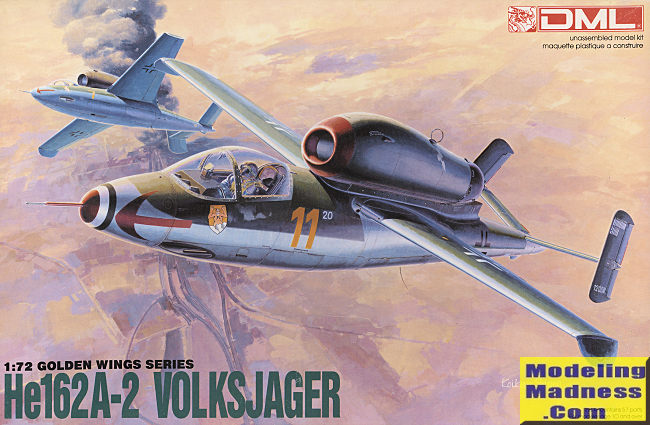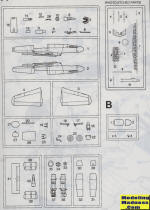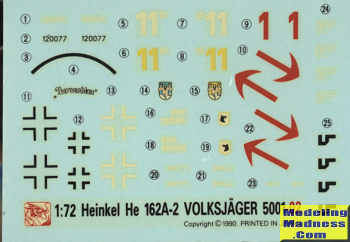
Dragon 1/72 He-162A
| KIT #: | 5001 |
| PRICE: | $18-25.00 |
| DECALS: | Two options |
| REVIEWER: | Scott Van Aken |
| NOTES: | Includes small p.e. fret |

| HISTORY |
The Heinkel He 162 Volksjäger (German, "People's Fighter") was a German single-engine, jet-powered fighter aircraft fielded by the Luftwaffe in World War II. Developed under the Emergency Fighter Program, it was designed and built quickly and made primarily of wood as metals were in very short supply and prioritised for other aircraft. Volksjäger was the Reich Air Ministry's official name for the government design program competition won by the He 162 design. Other names given to the plane include Salamander, which was the codename of its wing-construction program, and Spatz ("Sparrow"), which was the name given to the plane by the Heinkel aviation firm.
The aircraft was notable for its small size; although almost the same length as a Bf 109, its wing was much shorter at 7.2 metres (24 ft) vs. 9.9 metres (32 ft) for the 109. Most distinctive was its top-mounted engine, which combined with the aircraft's ground-hugging landing gear allowed the engine to be easily accessed for maintenance. This made bailing out of the aircraft without hitting the engine difficult, and the He 162 is thus also notable as the first single-engine aircraft to mount an ejection seat in an operational setting. The small size left little room for fuel, which combined with the inefficient engine resulted in very low endurance on the order of 20 minutes, and it only had room to mount two autocannons, making it quite underarmed for the era.
A series of fatal accidents during testing required a series of refinements that delayed the program, but the aircraft eventually emerged in January 1945 as an excellent light fighter. Although production lines were set up and deliveries began, the state of Germany by that time made the effort pointless. Of just less than 1,000 examples on the assembly lines, only about 120 were delivered to the airfields and most of those never flew, usually due to shortages of parts, fuel, and pilots. Small numbers were used in development squadrons and these ultimately saw combat in a few cases during April 1945, yet the He 162 also proved to be quite dangerous to its own pilots as its tiny fuel load led to a number of aircraft crashing off field, while additional losses were attributed to structural failure.
Production was still ongoing when the conflict ended in May 1945. Numerous aircraft were captured by the Allied forces along with ample supplies of parts from the production lines. Eric Brown flew one just after the war and considered it a first-rate aircraft with few vices. Several He 162s have been preserved in museum collections around the world.
| THE KIT |
 Based
on the part number, this is probably Dragon's first 1/72 aircraft kit, being
released in 1990. It is a good choice as the kit itself is basically three grey
plastic and one clear sprue with a small photo etch fret being used for some
engine detail and cockpit bits such as the instrument panel. Options for the kit
are few and include open or closed canopy, open or closed engine covers and you
can build it wheels up.
Based
on the part number, this is probably Dragon's first 1/72 aircraft kit, being
released in 1990. It is a good choice as the kit itself is basically three grey
plastic and one clear sprue with a small photo etch fret being used for some
engine detail and cockpit bits such as the instrument panel. Options for the kit
are few and include open or closed canopy, open or closed engine covers and you
can build it wheels up.
The cockpit is a bit odd with a seat, instrument panel/rudder pedal assembly, and nose gear well filling most of the space. There is no floor and oddly, no seat harness, which is a bit odd considering that it has a p.e. fret. The main gear well is nicely done and one needs to assemble it complete with the main gear prior to installation.
A full engine is supplied and even if building the kit with the cover
closed, needs to be installed. With all the previous sub assemblies finished,
they can be installed in the fuselage halves along with nose weight. Then the
wings, rear flight surfaces and the engine doors can be added. Flipping the kit
over, the gear doors and wheels can be attached. The main gear doors have to be
cut away from the center section for the gear down option. The last of ten
construction steps is for the clear parts.

Instructions use Gunze paint references and there are two markings options, both with JG.1 in the last month of the war. One is the box art plane in a dark green over light blue. For this option the red, white, and black nose ring needs to be painted. The other is in a two green upper surface. The decals are probably past their use by date as they are a bit yellow, but if you use aftermarket white insignia, they could well be salvaged.
| CONCLUSIONS |
The He-162 has a fairly interesting 1/72 kitting history. Prior to this one was the Lindberg and Frog versions, which weren't bad, but was not quite as well detailed. Since this one, there have been kits by Hobby Boss, Special Hobby, and AZ Model. I'd lean towards the Special Hobby kit if you want detail, with the Hobby Boss version being part of their easy build line. Not to say this isn't a good kit, as it still holds up very well.
| REFERENCES |
https://en.wikipedia.org/wiki/Heinkel_He_162
March 2023
Copyright ModelingMadness.com. All rights reserved. No reproduction in part or in whole without express permission from the editor.
If you would like your product reviewed fairly and fairly quickly, please contact the editor or see other details in the Note to Contributors.